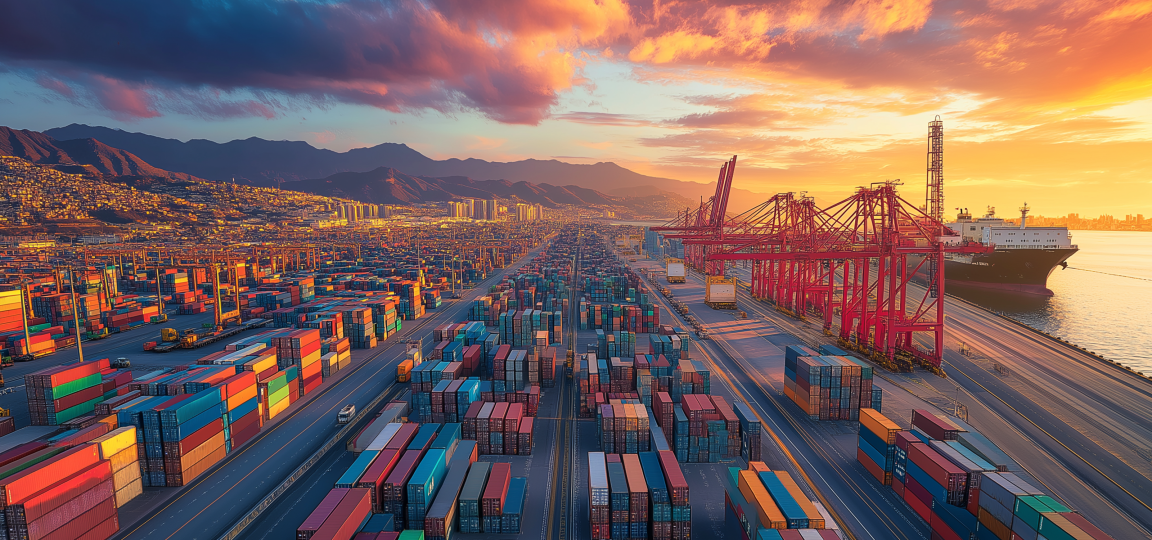Three key risks ahead
Unpredictable trade policies will shakeup supply chains
New tariffs and restrictions can instantly impact trade routes and profitability. Conflicts in Ukraine, the Middle East and Sudan are keeping constant pressure on conditions. The Red Sea and the Suez Canal have become critical points of tension. Maritime traffic through this canal fell by more than 50% in the last quarter of 2024 compared to the same period the previous year, with carriers preferring to take the Cape of Good Hope route. (Source: Coface). That colossal drop shows how fragile global trade routes can be. And companies overly reliant on a single supplier or shipping route were hit hardest.
You need to have a good grasp and tight control of commercial, economic and political risks right now, especially if you’re planning to grow your business.
It’s time to look for alternative supply chains to cut your risk.
“(Geo)political risk is now a lasting reality for global trade. Companies are forced to adapt to this multipolar environment, where the regionalisation of trade flows disrupts their supply chain and sometimes even their entire strategy. All the more so as additional factors, such as climate crises, will accentuate this trend.”
Ruben NIZARD, Head of Sector and Political Risk Analysis, Coface
Business partners’ finances are harder to judge
Business partners’ finances are harder to judge
A struggling or risky business partner can spell disaster. Financial instability isn’t always obvious—some companies mask problems with debt until it’s too late. Global bankruptcies are rising fast, with business bankruptcies up 40.3% in the U.S. over 12 months [CFA Institute].
Not conducting robust financial checks on potential business partners, or monitoring their financial health, can leave you vulnerable to mounting payment defaults and supply chain collapses.
Late payments and defaults are on the rise
When demand falls, delayed payments follow - and businesses without strong credit controls suffer. Even leading global firms are susceptible to these risks. In 2024, Sinochem, a critical player in China’s chemical, oil and agricultural sector, saw two of its three Shandong oil refineries collapse because of weak demand and high costs. Similarly, Bangladesh’s Beximco Group, a major textile exporter, fell into deep debt - potentially threatening buyers across 55 countries.
The impact of a partner’s default can ripple through supply chains, disrupting industries and causing cash flow crises. Exporters must anticipate shifts in creditworthiness and improve their risk assessments.
The four industries most at risk in2025
Some sectors are more vulnerable to shifting trade agreements, financial instability and logistics disruptions than others. For these businesses, the risks are even greater:
Manufacturing (automotive & semiconductors)
Trade tensions and rising raw material costs are making it harder for manufacturers to compete globally. U.S. tariffs on Chinese semiconductors and steel have already reshaped supply chains, forcing companies to rethink sourcing strategies. With Reuters flagging automotive as a sector to watch for bankruptcies in 2025, exporters need to be proactive in managing risk here.

Energy & natural resources
Energy markets are unpredictable. The U.S. became the world’s top energy exporter last year, only to face sudden European restrictions that slashed LNG sales by 15%. These rapid shifts mean exporters must constantly reassess their risk exposure and plan for price volatility.
Agriculture & food production
Beyond tariffs, agricultural exporters face climate risks and strict regulations. In 2024, UK food exports fell 6.1% because of post-Brexit red tape. Food has one of the most time-sensitive supply chains, so it’s crucial to monitor trade disruptions that could cause costly spoilage.
Transport & logistics
Freight rates fluctuate sharply, and shipping crises can bring trade to a standstill. The Red Sea attacks in 2024 forced Tesla and Volvo to suspend production because they were missing critical car parts. But they might have avoided the problem if they weren’t so heavily reliant on one trade route.
How can you stay ahead of the risks?
Exporters need early, reliable insights to make confident decisions in an unpredictable world. Urba360by Coface Business Information helps you assess business partners with a consistent Score across all sectors and 200 countries – giving you a clear, comparable view of risk.
Whether you’re extending credit terms or onboarding new suppliers, Urba360 delivers real-time insights to help you:
- Benchmark counterparties globally with a unified Score.
- Guide payment terms decisions.
- Evaluate sector-specific trade conditions.
- Analyse international partner’s positioning in the market.
- Monitor geopolitical risks.
- Identify potential payment delays.


 Worldwide
Worldwide
 France
France
 Germany
Germany
 United Kingdom
United Kingdom
 Italy
Italy
 United States
United States
 Spain
Spain
 Poland
Poland
 Romania
Romania
 Croatia
Croatia
 Australia
Australia
 Austria
Austria
 Belgium
Belgium
 Brazil
Brazil
 Bulgaria
Bulgaria
 Czech Republic
Czech Republic
 Denmark
Denmark
 Finland
Finland
 Greece
Greece
 Hungary
Hungary
 India
India
 Japan
Japan
 Lithuania
Lithuania
 Netherlands
Netherlands
 New Zealand
New Zealand
 Norway
Norway
 Serbia
Serbia
 Slovakia
Slovakia
 South Africa
South Africa
 Sweden
Sweden
 United Arab Emirates
United Arab Emirates
